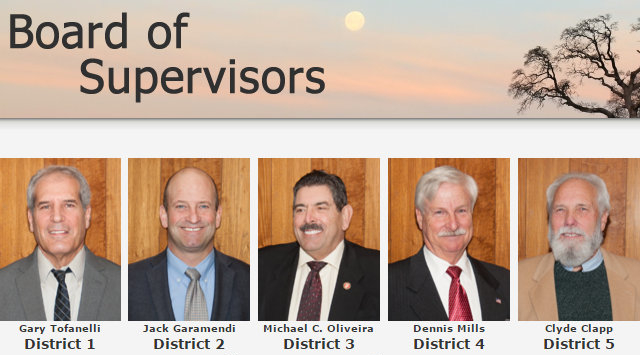San Andreas, CA…The Calaveras County Board of Supervisors are back in action on December 19th. The Complete Agenda is below. On October 17, 2017 the Board of Supervisors heard a recommendation from the Planning Commission to adopt an ordinance either banning cannabis cultivation and other commercial activities associated with cannabis or regulating those uses. The hearing was continued to October 24, 2017 to consider additional information provided at the hearing. At the continued hearing Supervisor Tofanelli identified a number of provisions that he stated must be included in an ordinance regulating cannabis. The Board directed staff to craft a regulatory ordinance that would include the requirements of Supervisor Tofanelli and be presented to the Planning Commission for consideration and then bring the recommendation of the Planning Commission back to the Board of Supervisors for possible adoption.
Staff prepared a draft ordinance that included Supervisor Tofanelli’s requirements as well as the other provisions included in the Planning Commission’s recommendation to the Board of Supervisors on October 2, 2017 and presented that to the Planning Commission on November 29, 2017. That draft, with non-substantive edits and additional provisions to address concerns by the Environmental Management Agency and the Sheriff is provided as Ordinance Alternative 1 (Attachment 1 – Board of Supervisors).
The Planning Commission, however, at its November 29, 2017 hearing, forwarded a recommendation to the Board to consider two other alternatives. These are a revised regulatory ordinance–a revision to Alternative 1 that includes a number of changes to the recommendations of the Board of Supervisors (Ordinance Alternative 2 – Planning Commission/Attachment 2)–and the ban alternative as previously recommended and provided to the Board on October 17, 2017 (Ordinance Alternative 3 – Ban /Attachment 3). The Planning Commission recommended that Alternatives 2 and 3 be equally weighted. The following list highlights the primary differences between the Board of Supervisors’ and the Planning Commission’s regulatory alternatives:
A provision was added to the purpose and intent stating that a reason for the ordinance was to provide sufficient funding to enforce regulations on illegal cultivators.
The cap of 50 outdoor or mixed light registrations was eliminated.
The minimum parcel size for outdoor or mixed light registration was established at 20 acres, and could be five acres if the parcel was surrounded entirely by land zoned A1, AP and/or GF (zones in which cannabis cultivation could be permitted.) A discretionary permit, neighbor notice, and Planning Commission review would still be required if a registration is sought for a parcel adjacent to any residential zoned parcel or any parcel with a legal dwelling already on it.
State-licensed self-distribution (limited distribution by the cultivator of cannabis produced only by that cultivator) is not prohibited.
The requirement that cannabis be grown in containers was eliminated.
More than one cultivation registration would be permitted per Williamson Act contract, but it would still be limited to one registration per parcel.
The limitation of one registration per person or entity was eliminated.
Setback requirements were modified to provide for a 500’ setback from an adjacent residential structure, or 200’ from a parcel not zoned residential or Residential Agricultural. The 500’ setback would apply if adjacent to residential or RA zoning.
The requirement that a permitted, permanent residence be on the parcel in order to cultivate was eliminated. A permitted structure would still be required, but not necessarily a dwelling.
Both regulatory ordinances limit the zoning of parcels on which cannabis may be cultivated commercially to the General Agricultural (A1), Agricultural Preserve (AP), and General Forest (GF) zones. Attachment 7 is a map of the county that depicts where parcels of 50 acres or more with those zones are located. Attachment 8 is the same map, but with parcels that are adjacent to residential or residential-agricultural zones which would require discretionary review under either draft highlighted in shades of red.






